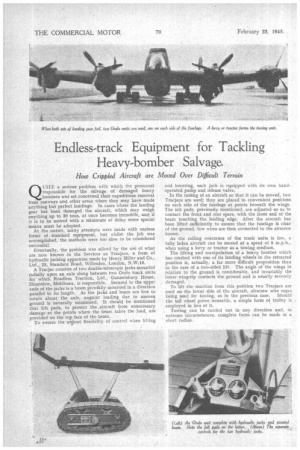Endless-track Equipment for Tackling Heavy-bomber Salvage.
Page 32

If you've noticed an error in this article please click here to report it so we can fix it.
How Crippled Aircraft are Moved Over Difficult Terrain
Q(ATE a serious problem with which the personnel responsible for the salvage of damaged heavy bombers was set concerned their expeditious removal from runways and other areas where they may have made anything but perfect landings. In cases where the landing gear has been damaged the aircraft, which may weigh anything up to 20 tons, at once becomes immobile, and if it is to be moved with a minimum of delay some special means must be adopted.
At the outset, many attempts were made with various forms of standard equipment, but whilst the job was accomplished, the methods were too slow to be considered successful.
Eventually, the problem was solved by the use of what are now known in the Services as Tracjacs, a form of hydraulic jacking apparatus made by Henry Miller and Co., Ltd., 23, Standard Road, Willesden, London, N.W.10. A Tracjac consists of two double-telescopic jacks mounted radially upon an axle slung between two Orolo track units for which Roadless Traction, Ltd., Gunnersbury House, Hounslow, Middlesex, is responsible. Secured to the upper ends of the jacks is a beam pivothlly mounted in a direction parallel to its length. As the jacks and beam are free to rotate about, the axle, angular loading due to uneven ground is naturally minimized. It should be mentioned that felt pads, to protect the ,aircraft from unnecessary damage at the points where the beam takes the load, are provided on the top face of the beam. To ensure the utikost flexibility of control when lifting and lowering, each jack is equipped with its own handoperated pump and release valve.
• In the raising of an aircraft so that it can be moved, two Tracjacs are used; they are placed in convenient positions on each side of the fuselage at points beneath the wings. The felt pads, previously mentioned, are adjusted so as to contact the front and rear spars, with the front end of the beam touching the leading edge. After the aircraft has been lilted sufficiently to ensure that the fuselage is clear of the ground, tow wires are then connected to the airscrew bosses.
As the rolling resistance of the track units iS low, a fully laden aircraft can be moved at a speed of 5 m.p.h., when using a lorry or tractor as a towing medium.
The lifting and manipulation of a heavy bomber which has crashed with one of its landing wheels in the retracted position is, actually, a far more difficult proposition than in the case of a two-sided lift. The angle of the wings in relation to the ground is considerable, and invariably the lower wing-tip contacts the ground and is usually severely damaged.
To lift the machine from this position twoTracjacs are used on the lower side of the aircraft, airscrew wire ropes being used for towing, as in the previous case. Should the tail wheel prove unusable, a simple form of trolley is employed in lieu of it.
Towing can be carried out in any direction and, in extreme circumstances, complete turns can be made ill a short radius.




















































